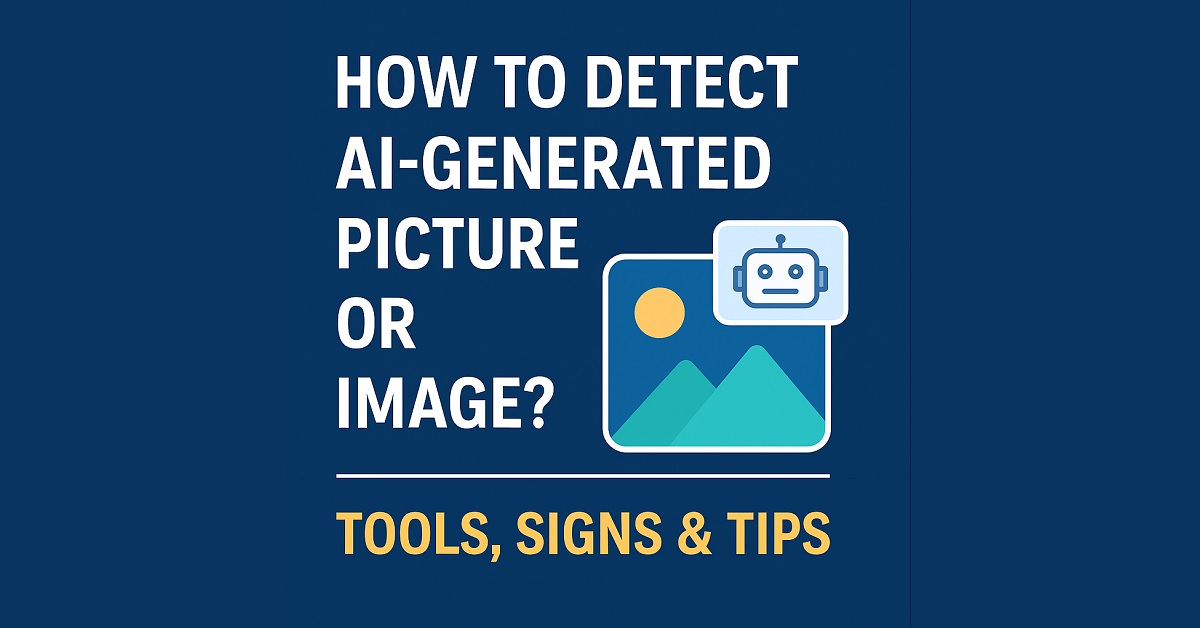In today’s world, AI-generated images have become incredibly realistic and are widely used in everything from social media posts and advertising to fake profiles and news. While AI image generators like DALL·E, Midjourney, and Stable Diffusion can produce stunning visuals, this also brings up a serious concern:
How can you identify whether an image is real or generated by AI?

Whether you’re a journalist, teacher, content creator, or a regular internet user, it’s important to know how to spot fake or AI-generated images. In this blog, we’ll explore the most effective tools, manual techniques, and clues to help you detect such images.
🎯 Why Should You Detect AI-Generated Images?
- ✅ To prevent the spread of misinformation
- ✅ To identify fake profiles or identity fraud
- ✅ To verify news or journalistic content
- ✅ To spot unethical use in academic or design projects
- ✅ To ensure authenticity in legal and forensic fields
🧰 Best AI Image Detection Tools (Free & Paid)
1. Hive Moderation
- Website: hivemoderation.com
- Detects AI-generated images, NSFW, deepfakes, and manipulated media
- Offers high accuracy with real-time detection
2. Sensity AI (Deepware Scanner)
- AI security platform to detect deepfake images and synthetic media
- Often used by law enforcement and media houses
3. AI or Not
- Website: aiornot.com
- Simple drag-and-drop tool to test if an image is AI-generated
- Uses machine learning for real-time detection
4. Illuminarty
- Detects both AI-generated and tampered images
- Offers Chrome Extension for social media image checks
5. Microsoft Authentication Metadata Tool
- Checks for AI-generated image inconsistencies in metadata
- Primarily used in professional settings
🔍 Manual Techniques to Detect AI-Generated Images
Even if you don’t use a tool, these clues can help you identify fake or AI-generated images:
1. Check for Strange Eyes or Teeth 👁️🦷
AI tools often struggle with realistic eye reflections, pupils, or overly sharp or crooked teeth.
2. Look at the Background 🖼️
AI images sometimes show distorted, warped, or blended backgrounds that make no logical sense (e.g., missing door frames, deformed objects).
3. Check for Asymmetry or Mirrored Features 🔁
AI may create symmetrical ears, earrings, or accessories even when they should be slightly different.
4. Unnatural Lighting or Shadows 🔦
AI may generate inconsistent lighting, impossible reflections, or unrealistic shadows.
5. Image Quality vs. Details
High image quality with odd details or glitches (e.g., 6 fingers, too many earrings, blurred logos) is a red flag.
🧠 Bonus: Use Reverse Image Search
Use Google Reverse Image Search or TinEye.com to:
- Find if the image exists elsewhere on the internet
- Check its origin, context, or if it’s a known AI sample
- Identify copied stock images from free AI sources
📸 What Types of AI Images Are Harder to Detect?
- AI avatars and profile pictures
- Hyper-realistic landscapes or interiors
- AI-generated artwork or abstract photos
These are often generated by Midjourney or DALL·E with great detail and minimal flaws.
🛡️ How to Protect Yourself Online
- Don’t trust profile pictures blindly—use reverse image tools
- Verify news images and viral photos from official media
- Use AI detection plugins if you’re a researcher or journalist
- Always ask for source or creator credits
🔚 Conclusion
AI-generated images are becoming a double-edged sword — useful yet potentially deceptive.
With the right combination of tools, manual checks, and common sense, you can protect yourself from being misled by synthetic visuals.
Whether you’re scrolling social media, verifying a profile picture, or editing content, these tips will help you stay one step ahead.